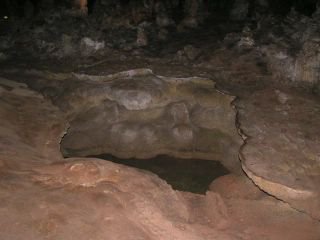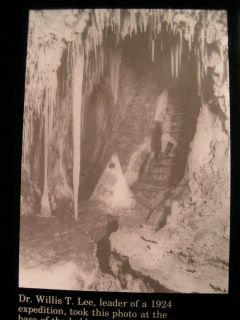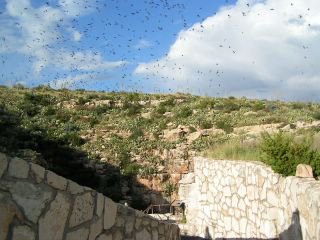Monday, October 10th
Photos of the Big Room can't possibly do it justice. But our attempts are below.
After touring the Big Room, we had a very hasty lunch at the Visitors Center and headed for...
The Lower Cave
After we donned our hard hats with battery powered lights, our guide, Erin, gave instructions on the importance of relaying information that she would provide back to the next person in line. She said she would be checking to be sure the information was making it to the end of the line. We then waited for the elevator to take us down to the cave.
The Lower Cave Tour began with "just holding on to a rope for balance on a slippery area." That was the original description of the rope when I called the Cavern the inquire. It is actually rappelling down a 45 degree angle slippery slope. Once down, you have to maneuver through some awkward steps to reach the ladders.
There are three ladders, the first is 4 feet, then 12 feet and the last is 20 feet. Going down you have to call out your progress. "On ladder one. Off ladder one. On ladder two, off ladder two," etc. Erin asked anyone with a fear of heights to go first.
Once down the ladders we were introduced to the ORANGE TAPE and the STRIPED TAPE. The path you can walk has orange tape on either side. But sometimes there is striped tape in the middle of the path. You can't step inside the striped tape because you will destroy a budding stalagmite. They take thousands of years to form and you can crush 100 years of growth in one little step. There were also places where the striped tape indicated danger. It was used for a combination of safety and preservation.
After we traversed the long obstacle course, we were treated to a trip through the most beautiful passage of white calcified popcorn. There were droplets everywhere and you could see it sparkle. I actually watched a drop fall.
We were then given a choice of walking through another passage or crawling through a 20 foot tunnel to the next room. The tunnel was not difficult at all, though there was a fork -- the wrong way would lead to a dead end. The small room at the end of the tunnel was a perfect place to stop for a Halloween ghost story -- just before turning all our lights out for the true cave experience.
The next passage was a backbreaker -- you have to bend over most of the way through. At the end is a large room and when you finally straighten up, you will soon see Boles Formation. They are stalagmites that have fused with the ceiling -- but they are cracked.
Around another curve are the soda straws. My first view included a thick white stalagmite that appeared to be directly beneath them. The thousands of thin stalactites (soda straws), made it look just like a shiny white crystal tree.
We saw the calcified bat and a demonstration of the phosphoresce in the cave.
Then there was the popcorn pool where drops splattered the minerals, forming tiny balls.
There is a long crack along the bottom of one side of the chamber. It is so ancient that it has stalactites forming under it. It is actually the ceiling of a cave that is even lower than Lower Cave. I guess that one would be "Lowest" Cave? There is a huge chunk of the ceiling of Lower Cave that fell so hard it fused with the ground. What caused all this? Earthquake? Did the fall from the ceiling cause the crack in the floor? Or vice versa?
You can't miss the Texas Toothpick, but in all honesty it wasn't as impressive as expected. The other unusual formations were what made the tour worthwhile.
Erin talked about the lost cave, Lechuguilla, rediscovered in 1986, and its 12,000 new micro-organisms. Each pool in Lechuguilla is a self contained ecosystem. One of those micro-organisms produces an enzyme that kills breast cancer cells, leaving the healthy tissue unharmed..
I've probably missed something, but these are the things that left an impression.
Then we had to return. Over rocks, rubble, around pools, through more passages until we were back at the obstacle course again.
And the ladders! It has been three strenuous hours and what came down must go back up. The ladders were not a problem. I was ready for that. The maneuver up through the ladder entrance was tricky. Then came the slippery slope!
I couldn't rappel up it. My right knee gave out every time I reached the "second" step. Finally, with help from behind and above, I literally crawled out. Kissed the first good stalagmite I reached, then pulled up, over and out -- I was never so happy to be done! Glad we did it -- but sore and bruised all over.
I have a whole new perspective about slippery slopes -- I'll never hear those words again without thinking of the Lower Cave tour. The tour is not for anyone who isn't in really good physical condition.
We turned in our helmets and returned to find Joe and Voncile waiting to go see...
The Bat Flight
The amphitheatre for the bat flight is down the hill from the Visitors Center. The thought of walking back uphill afterwards wasn't very appealing.
There is supposed to be a brief lecture before the bat flight -- but the bats didn't cooperate. They had a schedule of their own and began leaving the cave long before the Ranger arrived (he was on time).
There were not as many bats as I expected. They didn't darken the sky. Possibly due to the cooling weather. And then there was the long walk back uphill to the parking lot. OUCH!
The Rainbow
In the parking lot we were treated to the most beautiful rainbow I have ever seen. As we headed back to White's City, it became a double rainbow and even more brilliant with every turn. A perfect end to a long anticipated adventure.
More information on Lechuguilla can be found at:
Wikipedia-Lechuguilla Cave
Microbially Influenced Corrosion in Lechuguilla and Spider Caves
Lechuguilla Restoration: Techniques Learned in the Southwest Focus on Microbial Preservation
Life Below the Surface
Scientists use Lechuguilla cave to test theories of life on Mars































